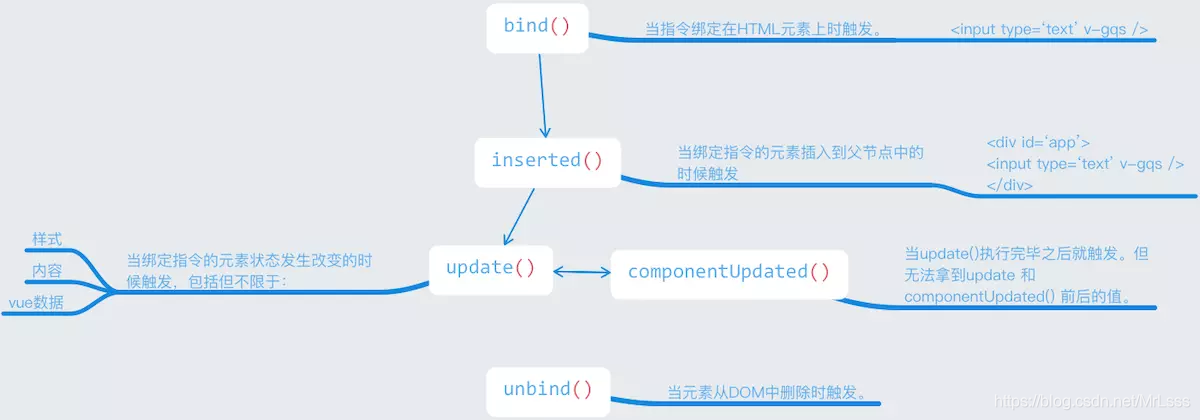Vue自定义指令
Vue指令的声明周期函数:
Vue.directive('gqs',{
bind() {
// 当指令绑定到 HTML 元素上时触发.**只调用一次**
console.log('bind triggerd')
},
inserted() {
// 当绑定了指令的这个HTML元素插入到父元素上时触发(在这里父元素是 `div#app`)**.但不保证,父元素已经插入了 DOM 文档.**
console.log('inserted triggerd')
},
updated() {
// 所在组件的`VNode`更新时调用.
console.log('updated triggerd')
},
componentUpdated() {
// 指令所在组件的 VNode 及其子 VNode 全部更新后调用。
console.log('componentUpdated triggerd')
},
unbind() {
// 只调用一次,指令与元素解绑时调用.
console.log('unbind triggerd')
}
})
-unbind() 一个把元素从DOM删除触发unbind().—> 仅仅是删除.
-componentUpdated() 一个显示设置元素的隐藏和显示的时候触发 componentUpdated() —> block | none 都触发.位置发生了改变,也会触发(改变是与Vue操作相关)
显示/隐藏 (v-if & v-show)
样式改变 (:class={active:isActive})
内容改变 (v-model=“text”)

局部(组件自定义指令):
var app = new Vue({
directives: {
innerDirective:{
bind() {
},
inserted() {
},
update() {
},
componentUpdated() {
},
unbind() {
}
}
})
指令钩子:
Vue 为自定义指令提供了一系列钩子。 每个钩子都有一些参数选项。 以下是可用的钩子:
bind - 当指令附加到元素时会发生的情况。
inserted - 一旦元素插入父 DOM 就会发生这种情况
update - 这在元素更新时发生,但子项尚未更新
componentUpdated - 一旦更新了组件和子组件,就会发生这种情况
unbind - 删除指令后会发生这种情况
其中每个都有 el,binding 和 vnode 参数可供他们使用。 这些论点是:
el - 绑定所依赖的元素
binding - 一个包含传递给钩子的参数的对象。 有许多可用的参数,包括 name,value,oldValue,expression,arg 和 modifiers。
vnode - 允许您根据需要直接引用虚拟 DOM 中的节点。
binding 和 vnode 都应该被视为只读。
update 和 componentUpdated 都公开了一个名为 oldvnode 的附加参数。 oldvnode 参数用于区分传递的旧值和较新的值。
实例:
Vue.directive("color", function(el, binding, vnode) {
el.style.color = binding.value;
});
Vue官网文档引用:
当页面加载时,该元素将获得焦点 (注意:autofocus 在移动版 Safari 上不工作)。事实上,只要你在打开这个页面后还没点击过任何内容,这个输入框就应当还是处于聚焦状态。现在让我们用指令来实现这个功能:
// 注册一个全局自定义指令 `v-focus`
Vue.directive('focus', {
// 当被绑定的元素插入到 DOM 中时……
inserted: function (el) {
// 聚焦元素
el.focus()
}
})如果想注册局部指令,组件中也接受一个 directives 的选项:
directives: {
focus: {
// 指令的定义
inserted: function (el) {
el.focus()
}
}
}然后你可以在模板中任何元素上使用新的 v-focus 属性,如下:
<input v-focus>钩子函数
一个指令定义对象可以提供如下几个钩子函数 (均为可选):
bind:只调用一次,指令第一次绑定到元素时调用。在这里可以进行一次性的初始化设置。inserted:被绑定元素插入父节点时调用 (仅保证父节点存在,但不一定已被插入文档中)。update:所在组件的 VNode 更新时调用,但是可能发生在其子 VNode 更新之前。指令的值可能发生了改变,也可能没有。但是你可以通过比较更新前后的值来忽略不必要的模板更新 (详细的钩子函数参数见下)。
componentUpdated:指令所在组件的 VNode 及其子 VNode 全部更新后调用。unbind:只调用一次,指令与元素解绑时调用。
接下来我们来看一下钩子函数的参数 (即 el、binding、vnode 和 oldVnode)。
钩子函数参数
指令钩子函数会被传入以下参数:
el:指令所绑定的元素,可以用来直接操作 DOM 。binding:一个对象,包含以下属性:name:指令名,不包括v-前缀。value:指令的绑定值,例如:v-my-directive="1 + 1"中,绑定值为2。oldValue:指令绑定的前一个值,仅在update和componentUpdated钩子中可用。无论值是否改变都可用。expression:字符串形式的指令表达式。例如v-my-directive="1 + 1"中,表达式为"1 + 1"。arg:传给指令的参数,可选。例如v-my-directive:foo中,参数为"foo"。modifiers:一个包含修饰符的对象。例如:v-my-directive.foo.bar中,修饰符对象为{ foo: true, bar: true }。
vnode:Vue 编译生成的虚拟节点。移步 VNode API 来了解更多详情。oldVnode:上一个虚拟节点,仅在update和componentUpdated钩子中可用。
除了 el 之外,其它参数都应该是只读的,切勿进行修改。如果需要在钩子之间共享数据,建议通过元素的 dataset 来进行。
这是一个使用了这些属性的自定义钩子样例:
<div id="hook-arguments-example" v-demo:foo.a.b="message"></div>Vue.directive('demo', {
bind: function (el, binding, vnode) {
var s = JSON.stringify
el.innerHTML =
'name: ' + s(binding.name) + '<br>' +
'value: ' + s(binding.value) + '<br>' +
'expression: ' + s(binding.expression) + '<br>' +
'argument: ' + s(binding.arg) + '<br>' +
'modifiers: ' + s(binding.modifiers) + '<br>' +
'vnode keys: ' + Object.keys(vnode).join(', ')
}
})
new Vue({
el: ‘#hook-arguments-example’,
data: {
message: ‘hello!’
}
})
动态指令参数
指令的参数可以是动态的。例如,在 v-mydirective:[argument]="value" 中,argument 参数可以根据组件实例数据进行更新!这使得自定义指令可以在应用中被灵活使用。
例如你想要创建一个自定义指令,用来通过固定布局将元素固定在页面上。我们可以像这样创建一个通过指令值来更新竖直位置像素值的自定义指令:
<div id="baseexample">
<p>Scroll down the page</p>
<p v-pin="200">Stick me 200px from the top of the page</p>
</div>Vue.directive('pin', {
bind: function (el, binding, vnode) {
el.style.position = 'fixed'
el.style.top = binding.value + 'px'
}
})
new Vue({
el: ‘#baseexample’
})
这会把该元素固定在距离页面顶部 200 像素的位置。但如果场景是我们需要把元素固定在左侧而不是顶部又该怎么办呢?这时使用动态参数就可以非常方便地根据每个组件实例来进行更新。
<div id="dynamicexample">
<h3>Scroll down inside this section ↓</h3>
<p v-pin:[direction]="200">I am pinned onto the page at 200px to the left.</p>
</div>Vue.directive('pin', {
bind: function (el, binding, vnode) {
el.style.position = 'fixed'
var s = (binding.arg == 'left' ? 'left' : 'top')
el.style[s] = binding.value + 'px'
}
})
new Vue({
el: ‘#dynamicexample’,
data: function () {
return {
direction: ‘left’
}
}
})
结果:
查看 CodePen 上 Vue ( @Vue) 的例子 Dynamic Directive Arguments.这样这个自定义指令现在的灵活性就足以支持一些不同的用例了。
函数简写
在很多时候,你可能想在 bind 和 update 时触发相同行为,而不关心其它的钩子。比如这样写:
Vue.directive('color-swatch', function (el, binding) {
el.style.backgroundColor = binding.value
})对象字面量
如果指令需要多个值,可以传入一个 JavaScript 对象字面量。记住,指令函数能够接受所有合法的 JavaScript 表达式。
<div v-demo="{ color: 'white', text: 'hello!' }"></div>Vue.directive('demo', function (el, binding) {
console.log(binding.value.color) // => "white"
console.log(binding.value.text) // => "hello!"
})